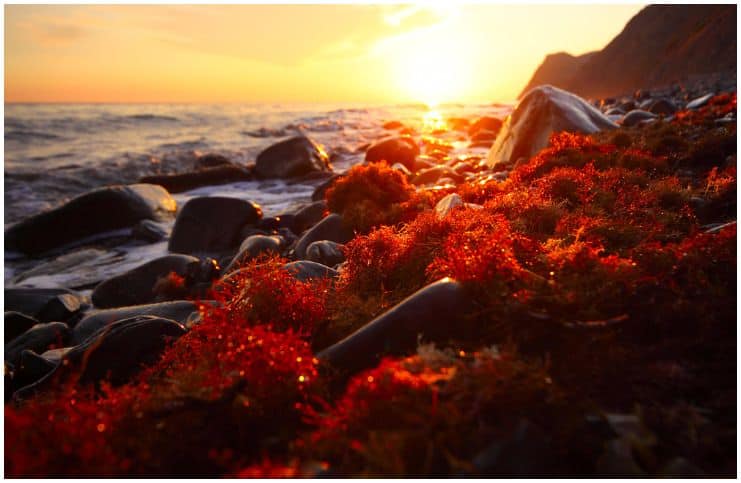Red Algae (Rhodophyta) – Facts, Uses, Health Benefits, Side Effects:
They are used for thousands of years in traditional Chinese medicine. Also known as seaweed. In recent years, they have been widely used in phytotherapy, mainly due to their medicinal properties.
They are classified as Archaeplastida, along with Viridiplantae (land plants and green algae) and glaucophytes, from which they diverge 1,500 Mya.
Uses
They are consumed by humans, representing a rich source of protein. It seems that they have a mineral content 20 times higher than plants growing in the ground. They may retain both their gelatinous nature and color when cooked.
Since ancient times, traditional Chinese medicine used red algae as a source of protein and minerals, and for the prevention of certain diseases. It is believed that they are used ever since the 3rd century BC.
The practical use of seaweed is varied. Species that live in the North Sea – chondrus – are used as a remedy for respiratory tract diseases.
Also, the pastry and microbiology industry appeals to seaweed in order to obtain vegetables used in the manufacturing process. Furthermore, some rhodophytes are economically important as providers of gels and food.
They play an important role in marine ecosystems since they are responsible for a big percentage of the air we breathe.
Facts
The study of seaweed began in the 70s by researchers in China and Japan.
There are over 6000 species of Rhodophyta, whose common feature is the presence of the red pigment called phycoerythrin and other pigments as well.
The vast majority of red algae are multicellular, reaching a significant height (up to 2 m). Because they contain phycoerythrin, which absorbs blue light waves, they can be found deeper in the ocean than some other types of algae.
Coralline algae is a very important group of this type of algae, and secrete calcium carbonate (the carbonic salt of calcium – CaCO3) onto the surface of their cells. They also represent the 1st identifiable fossils we have of advanced, sexually reproducing life.
Their dismembered thallus consists of stems and leaves. Their body is very tender and delicate. Due to the fact that they absorb blue light that can travel great depths, they can be found at greater depths than other algae.
Around 5 percent of this type of algae live in freshwater environments.
They have a variety of colors, from bright red to almost black. In combination with bizarre shapes, they determine the incomparable beauty of the underwater kingdom.
Some of them have very little red pigment, therefore, they may appear bluish or green in color. Additionally, rhodophytes have complex life cycles with 2 or 3 stages, involving the alternation of generations.
During photosynthesis, algae release oxygen that dissolves in water, being necessary for the breathing process of fish and other aquatic animals.
Health Benefits of Red Algae (Rhodophyta)
#1 A good source of nutrients
They contain high amounts of fiber, protein, and minerals, thus considered an important nutritional food. Moreover, some researchers believe that seaweed, in general, represents the greatest source of vitamins in the world.
#2 Boosts the immune system
They help improve the immune system, stimulating the functions of leukocytes. They stimulate interferon, a protein that protects the body against viruses’ proliferation.
Recent studies have shown that seaweed prevents the proliferation of herpes simplex virus.
#3 UTIs treatment
It seems that this type of algae is a great adjuvant in the treatment of urinary tract infections, asthma, stomach disorders, skin diseases, boils, obesity, and high cholesterol levels. They also proved to be effective in the treatment of ulcers and tumors.
#4 Free radicals protection
Another important benefit of rhodophytes is their strong antioxidant effect, which counters the damage free radicals do to cells. Free radicals are highly reactive substances that burrow their way into healthy cells, causing permanent damage.
They are common by-products of normal internal reactions. Furthermore, pollution, UV radiation, and strenuous aerobic exercise have been strongly connected with free radical formation.
#5 Vitamin K
Rhodophytes are also a good source of vitamin K, an important fat-soluble vitamin that plays vital roles in building your bones, protecting your heart, helping your blood to clot properly, and optimizing your insulin levels.
Symptoms of a deficiency in vitamin K include hemorrhage, prolonged clotting time, and excessive bleeding.
#6 Dietary fiber
Red marine algae have a high content of fiber. Dietary fiber, also known as bulk or roughage, includes the parts of plant foods your physical body can’t absorb or digest.
It plays an important role in your heart, digestive, and skin health, and may improve glycemic levels (ideally for type 2 diabetics) as well as in a healthy weight loss.
Side Effects
Due to the high levels of iodine in red algae, using an extract from these algae could lead to in an overdose of iodine. Some symptoms of an iodine overdose include:
- shortness of breath;
- vomiting;
- fever;
- delirium;
- abdominal pain.
More importantly, consuming too much iodine can lead to iodine-induced hyperthyroidism. Signs and symptoms of hyperthyroidism include:
- unexplained weight loss;
- warm skin;
- muscle weakness;
- fast heart rate.
Algae supplements can also negatively interact with medications that decrease the immune system and drugs that slow blood clotting. The most commonly used anticoagulant are coumarins, like – warfarin and phenprocoumon.
READ THIS NEXT:
Pickled Banana Peppers health benefits & side effects
Purslane: Health Benefits for Hair, Side Effects & Nutritional Value
References https://www.ncbi.nlm.nih.gov/pmc/articles/PMC4337235/ http://www.pnas.org/content/114/31/E6361 https://www.jstor.org/stable/2436105?seq=1#page_scan_tab_contents
